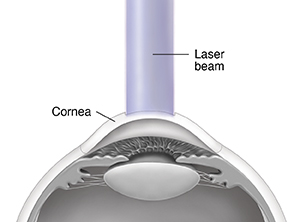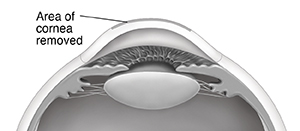A
B
C
D
E
F
G
H
I
J
K
L
M
N
O
P
Q
R
S
T
U
V
W
X
Y
Z
Topic IndexLibrary Index
Click a letter to see a list of conditions beginning with that letter.
Click 'Topic Index' to return to the index for the current topic.
Click 'Library Index' to return to the listing of all topics.
Refractive Surgery: PRK
PRK (photorefractive keratectomy) is a procedure to reshape the cornea. It may help you see better without glasses or corrective lenses. This method uses an excimer laser. This laser makes a concentrated beam of ultraviolet (UV) light. Each pulse of the laser can remove a tiny part of the cornea. PRK can be used to treat the following:
What to expect
-
Before treatment, you may be given medicine to help you relax.
-
Eye drops will be put into your eyes to numb them. A device will be used to keep your eyes open and prevent you from blinking. You will be asked to stare at a target light so your eyes do not move.
-
A small surgical tool, an alcohol solution, or the laser is used to remove the surface of the central part of your cornea (the epithelium). Laser treatment lasts for 10 to 90 seconds.
-
After laser treatment, you will wear a contact lens as a bandage for a few days. This protects the cornea as it heals.
-
For a few days after the procedure, your vision may seem worse. It should start to improve in about 3 to 5 days. It may take a month or longer to achieve your best vision.


When to call your healthcare provider
Call your healthcare provider right away if you have any of these:
Cons of PRK
-
Mild to moderate pain after surgery
-
Longer vision recovery than LASIK
-
Possible use of eye drops for 3 months or longer
-
Risk of corneal scarring or haze
-
Risk of short-term (temporary) or long-lasting (permanent) dry eye
-
Risk of night vision problems, such as halos, glare, or starbursts
-
Risk of undercorrection or overcorrection
-
Risk of losing your best corrected vision
-
Risk of corneal infection
Pros of PRK
-
No risk of flap problems
-
Better for people with thin corneas, previous glaucoma surgery, mild corneal scars, or other cornea problems
Online Medical Reviewer:
Chris Haupert MD
Online Medical Reviewer:
Rita Sather RN
Online Medical Reviewer:
Tara Novick BSN MSN
Date Last Reviewed:
12/1/2022
© 2000-2025 The StayWell Company, LLC. All rights reserved. This information is not intended as a substitute for professional medical care. Always follow your healthcare professional's instructions.